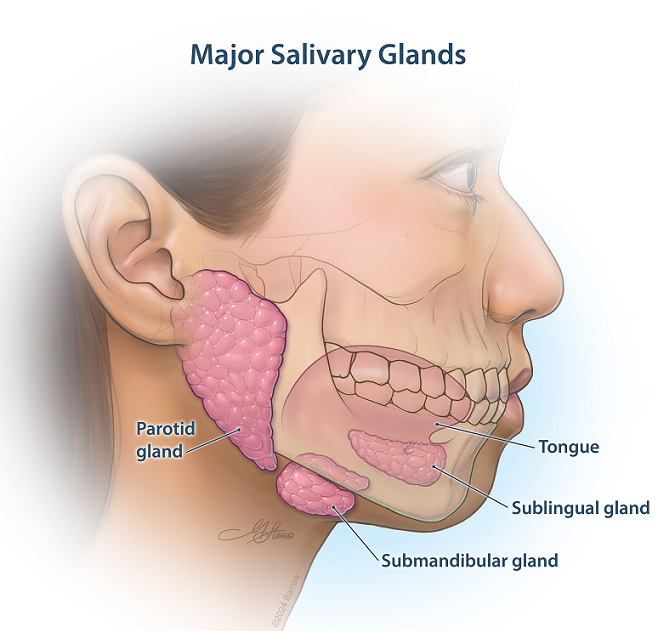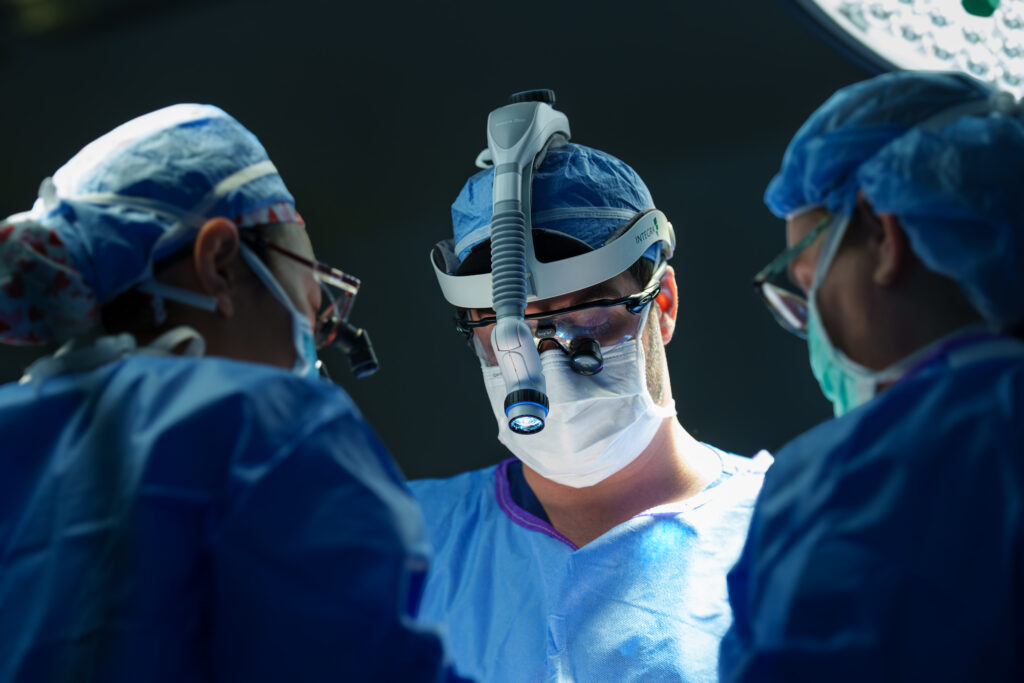
Salivary Gland Cancer
Overview
Salivary gland cancer is a rare type of head and neck cancer that occurs in the salivary glands. The most common places for these cancers to develop are in the three major salivary glands: the parotid glands (in front of the ears), the submandibular glands (under the jaw), and the sublingual glands (below the tongue).
Cancer is when cells in the body start to grow unchecked. In the case of salivary gland cancer, this process begins in the cells of one of these glands. The exact cause of this unchecked and abnormal growth is not always clear. Factors like smoking, specific environmental exposures, and previous radiation treatment of the neck and head can increase the risk.
Symptoms of salivary gland cancer might include a lump or swelling in or near your jaw, neck, or mouth; pain in your face, chin, or neck that does not go away; numbness in part of your face; muscle weakness on one side of your face; or trouble swallowing. However, these symptoms can be caused by other, less serious conditions. If you experience any of these symptoms, it’s essential to see a doctor so they can determine the cause.
Typically, the diagnosis of salivary gland cancer involves a physical examination, imaging tests like MRI or CT scans, and possibly a biopsy, where a small sample of tissue is taken from the tumor and examined under a microscope for cancer cells.
Treatment for salivary gland cancer depends on several factors, including the size and location of the tumor, whether the cancer has spread, and your overall health. Options might include surgery to remove the tumor, radiation therapy, chemotherapy, or a combination of these treatments.
While the prospect of facing any cancer can be daunting, it’s important to remember that treatment advances have improved outcomes for many people with salivary gland cancer. Working closely with your healthcare team to understand your diagnosis and treatment options is the best strategy for managing your health.
Overview of Salivary Glands and Salivary Disease
Salivary glands are located in your head and neck and produce saliva, which is vital for food digestion and oral health. There are numerous minor salivary glands and three major salivary glands:
- Parotid glands (in front of your ears)
- Submandibular glands (under your jaw)
- Sublingual glands (below your tongue)

Salivary gland disease can take the form of from inflammation and infections, stones that can block the flow of saliva, and tumors (both benign and cancerous). An ENT surgeon can treat stones, blockages, and inflammation of a salivary gland with minimally invasive techniques such as sialoendoscopy. Tumors and cancers, however, may require more complex treatment.
Types of Salivary Gland Tumors
Salivary gland cancer isn’t just one type; it’s a group of different cancers that can start in any of your salivary glands. The main forms include:
- Mucoepidermoid Carcinoma is the most common type. It can vary significantly in how fast it grows and how seriously it can affect your health. Some of these cancers grow slowly and are less aggressive, while others can grow more quickly and be more challenging to treat.
- Adenoid Cystic Carcinoma grows slowly but is challenging to treat because it can spread along the nerves. This means it can reach into areas that are hard to see or treat, like a plant’s roots growing under the ground. Even though it grows slowly, it’s known for being quite stubborn and can sometimes come back after treatment.
- Carcinoma ex Pleomorphic Adenoma begins as a benign (non-cancerous) tumor called a pleomorphic adenoma but becomes cancerous over time. While these tumors may look harmless initially, they can become dangerous.
- Adenocarcinoma includes various cancers that start in the cells that line your glands. They can occur in almost any type of glandular tissue (for example, the pancreas and prostate), including the salivary glands.
- Acinic Cell Carcinoma starts in the cells that make the digestive enzymes in saliva. It usually has a better outlook than other types because it usually grows slowly and is less likely to spread.
- Polymorphous Low-Grade Adenocarcinoma mainly occurs in the minor salivary glands, which are the smaller glands scattered throughout the mouth and throat. It generally grows slowly and has a good chance of being cured, especially if it has not spread.
Additional, though less common, forms of salivary gland cancer include:
- Adenosquamous carcinoma
- Basal cell adenocarcinoma
- Carcinosarcoma
- Clear cell carcinoma
- Cystadenocarcinoma
- Lymphoepithelial carcinoma
- Lymphomas
- Myoepithelial carcinoma
- Oncocytic carcinoma
- Poorly differentiated carcinoma
- Salivary duct carcinoma
- Sebaceous adenocarcinoma
- Secretory analogue carcinoma (similar to a type of breast cancer)
- Squamous cell carcinoma
Each type of salivary gland cancer is unique, with its own behavior and treatment strategies. Doctors determine the best course of action based on the type of cancer, its location, and whether or not it has spread to other parts of the body. The goal is to choose the treatment that offers the best chance of removing or controlling the cancer while minimizing side effects.
About the Salivary Glands
Your salivary glands make saliva, the watery liquid you feel in your mouth. Saliva has several essential functions, including:
- Moistening food, making it easier to chew and swallow
- Helping you taste your food
- Protecting your mouth
- Aiding food digestion by breaking down starches
Even when you’re not eating, your salivary glands produce a small amount of saliva to keep your mouth moist and healthy.

Symptoms of Salivary Gland Cancer
Several symptoms can be a warning sign for salivary gland cancer. People usually notice changes in the way their mouth and face feels or moves, and these differences can be subtle at first.
Symptoms can include:
- A Lump or Swelling: One of the most noticeable signs might be finding a lump or noticing swelling in one part of your face, neck, or mouth. It doesn’t usually hurt, but it’s something new or different that wasn’t there before.
- Pain: While some lumps are painless, salivary gland cancer can sometimes cause pain in the face, neck, or part of the mouth. The pain might not go away and could feel unusual or persistent. Salivary gland tumors that cause pain are almost always cancerous.
- Numbness: If you start feeling numbness in part of your face, it could be a symptom of a salivary gland tumor.
- Facial Weakness or Paralysis: this means that one side of your face might not move as well as the other. You might notice this when you smile or try to make facial expressions, and one side doesn’t respond like it should.
- Trouble Opening Your Mouth: Difficulty opening your mouth wide, like when you’re yawning or eating, could be a sign of a salivary gland tumor.
- Trouble Swallowing or Feeling Something Is Stuck: You might feel like food doesn’t go down as easily as it used to, or you might feel like something is stuck in your throat.
Other, less serious conditions can also cause these symptoms. If you or someone you know is experiencing these signs, particularly if they persist or worsen, it’s a good idea to check in with a doctor to find out what’s happening. They can help figure out if it’s something like an infection or if it’s something more serious like cancer that needs more attention.

Treatments for Salivary Gland Cancer
Treating salivary gland cancer can involve a few different methods, depending on the cancer’s size, type, and whether it has spread to other parts of the body.
Surgery
Surgery for salivary gland tumors is a type of head and neck cancer surgery and involves using specialized tools to remove the cancer from your body. The goal is to take out all of the cancer along with a small border of surrounding normal tissue to ensure no cancer cells are left behind. Sometimes, surgeons must remove nearby lymph nodes, small glands that help fight infection, if the cancer has spread to them.
Radiation Therapy
Radiation therapy uses super-focused beams of energy to target the cancer cells and destroy them or stop them from growing, all while trying to avoid harming the healthy cells around them. It’s often used after surgery to catch any cancer cells that might have been missed or as the primary treatment if surgery isn’t an option.
Chemotherapy
Chemotherapy is the use of specialized medicine that travels throughout your body to find and attack cancer cells wherever they are. It’s not used as often for salivary gland cancer as for other types of cancer. Still, it can be helpful in certain situations, mainly if the cancer has spread to other body parts.
Targeted Therapy
Targeted therapy uses drugs designed to seek out and attack specific parts of cancer cells that make them different from normal cells. Your doctor can use this treatment if the cancer has a particular characteristic the drug can target.
Immunotherapy
Immunotherapy is a way of helping your immune system identify and neutralize cancer cells more effectively. It’s like giving your body’s natural defenses an upgrade or a boost to fight the cancer.
The choice of treatment depends on various factors, including the type and stage of cancer and your overall health and preferences. Doctors often use a combination of these treatments to get the best results. The goal is always to remove or destroy as much of the cancer as possible and to help you feel better and live longer.
Common Questions
How common is salivary gland cancer?
Salivary gland cancer is relatively rare when compared to other types of cancer. It makes up a small percentage of all cancer cases. To give you a perspective, in the United States, salivary gland cancers account for less than 1% of all cancers and about 5% of cancers in the head and neck region. Every year, only a few people per 100,000 are diagnosed with this type of cancer.
Because it’s so uncommon, many people might not have heard of it until they or someone they know is diagnosed. Its rarity also means that it’s crucial to see specialists who have experience treating this type of cancer, as they can provide the most informed care and treatment options.
What is the survival rate for salivary gland cancer?
Survival rates for salivary gland cancer vary depending on several factors, including the type of cancer, its stage (how far it has spread), the location of the tumor, and your overall health. Because these cancers are rare, detailed statistics can be somewhat limited, but here’s a general overview:
Overall survival rates provide a snapshot of the percentage of people who survive for a specific time after their cancer diagnosis. For salivary gland cancer, the 5-year survival rate—which means the percentage of people who are alive at least five years after being diagnosed—varies widely but is generally considered to be around 60-70%. However, this number can be higher or lower based on the factors mentioned above.
Survival rates tend to be higher for people with early-stage salivary gland cancer, where the tumor is small and has not spread beyond the original gland. The survival rates decrease as the cancer becomes more advanced, spreading to nearby tissues, lymph nodes, or distant parts of the body.
The type of salivary gland cancer also affects survival rates. Some types, like low-grade mucoepidermoid carcinoma, tend to have a better prognosis because they grow slowly and are less likely to spread. In contrast, more aggressive types, such as high-grade mucoepidermoid carcinoma or adenoid cystic carcinoma, which can spread more easily, might have a lower survival rate.
Effective treatment can significantly impact survival rates. Early detection and treatment, tailored to the specific type and stage of cancer, can improve outcomes.
It’s important to remember that survival rates are based on averages from large groups of people. They cannot predict what will happen for any individual because everyone’s situation is unique. Advances in treatment are continually improving outcomes, and factors like overall health, treatment options, and how the cancer responds to treatment also play a critical role in an individual’s prognosis.
What is the average age of onset for salivary gland cancer?
Salivary gland cancer can occur at any age, but physicians most commonly diagnose it in adults in their mid-60s to early 70s. While it’s possible to see cases in younger adults, and even rarely in children, the average age of onset tends to be in the older adult population.
Each type of salivary gland cancer can have slightly different demographics regarding the age of onset. For example, certain kinds may be more likely to appear in slightly younger or older individuals. However, the general trend is that the risk increases with age, like many other types of cancer. Regardless of age, it’s essential to consider individual risk factors and symptoms and consult a healthcare provider if you have any concerns or unusual symptoms.
Resources
American Head and Neck Society
References
- Moustafa Mourad, Thomas Jetmore, Ameya A. Jategaonkar, Sami Moubayed, Erin Moshier, Mark L. Urken, Epidemiological Trends of Head and Neck Cancer in the United States: A SEER Population Study, J Oral Maxillofac Surg. 2017 Dec;75(12):2562-2572. doi: 10.1016/j.joms.2017.05.008. Epub 2017 May 22. PMID: 28618252.
- American Cancer Society. Salivary Gland Cancer. March 28, 2024.



